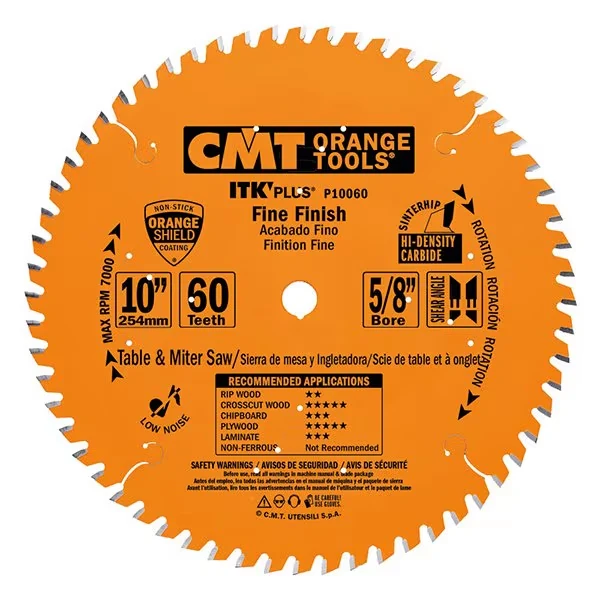Circular Saw Blades
ITK Plus Finish Saw Blade, 12 x 72 Teeth, 10deg ATB+Shear with 1-Inch bore
| Model | Item | Price (ex. VAT) | |
|---|---|---|---|
| P12072 | CY9BHC | - | RFQ |
ORANGE TOOLS Orange Chrome Ultimate Plywood And Melamine Blade 10 Inch x T80 HiATB, Silver
| Model | Item | Price (ex. VAT) | |
|---|---|---|---|
| 283.680.10 | CY9EFQ | - | RFQ |
Circular Saw Blades
Circular saw blades are discs with teeth for cutting a range of materials such as wood or metals by using spinning motion mechanism. Raptor Supplies offers these circular saw blades from brands like Dewalt, Milwaukee, Westward and Black & Decker. They feature grooves to minimise vibrations and can disperse heat that is caused by friction, thereby preventing damaged blades or overheating. These blades are ideal for miter, chop, circular, table, masonry and concrete saws in industrial and handheld tool applications. Further, they are configured with carbide / cermet / stainless steel / polycrystalline / steel tips for increased production rate and fast & smooth cutting. Choose from a wide range of these blades, available in diameters of 3, 4, 5, 6, 7, 8, 9, 10, 12, 14 and 16 inches.
Frequently Asked Questions
How do I install a circular saw blade?
- Unplug the saw if it has a power cord. In the case of a cordless saw, remove the battery.
- Loosen the arbour nut with the help of a wrench and remove it.
- Line up the new blade with the arbour, ensuring that the teeth are pointing in the correct direction. Now, push the blade onto the arbour as far as it will go.
- Once the blade is placed, tighten the arbour nut with a wrench, ensuring that the blade is tight enough that it does not move or wobble.
- Plug in / insert the battery of the saw and test the blade to ensure it is rotating correctly.
What are the factors to consider when choosing a circular saw blade?
- Material: The type of material the blade will be cutting, such as wood, metal or concrete.
- Blade size: The diameter of the blade should match the size of the saw to achieve accurate cuts.
- Number of teeth: More teeth on a blade result in a smoother & finer cut, whereas fewer teeth allow faster cutting.
- Blade quality: Blades made from high-quality materials with precision ground teeth achieve desirable results.
- Kerf: The thinner kerf (width of the tooth) produces less resistance in the cut, while a thick or full kerf creates a wider slot in the material.
- Arbour size: The arbour size of a circular saw blade refers to the diameter of the centre hole on the blade. Choosing a blade with the correct arbour size prevents the blade from wobbling and creating an unsafe cutting condition.
- Blade coatings: Blades with coatings like TiN, TiC or C3 stay sharper for a long time and prevent rust.
Popular Search Queries
Explore More
- KEYSHAFT
- Air Brake Accessories
- Machining Vises
- Ceramic Fiber Insulation
- Spiral Saw Accessories
- Oil Metering
- Liberator Hand Truck T Rod Style Tread Brake Kits - B & P MANUFACTURING
- Mail Drop Door - SALSBURY INDUSTRIES
- Mechanical Blade Micrometers - INSIZE
- Roller Links - BROWNING
- 28-359 Activarmr Nitrile Coating Cut Resistant Gloves - ANSELL
- EBVB Series Electrical Actuated Ball Valves - PLAST-O-MATIC
- Tyvek Double Bib High Pressure Hard Hat Hoods, Deluxe - ALLEGRO SAFETY
- GPL 217 Series Extreme Pressure Grade Grease - KRYTOX
- CP3550 Series Angle Grinders - CHICAGO PNEUMATIC


